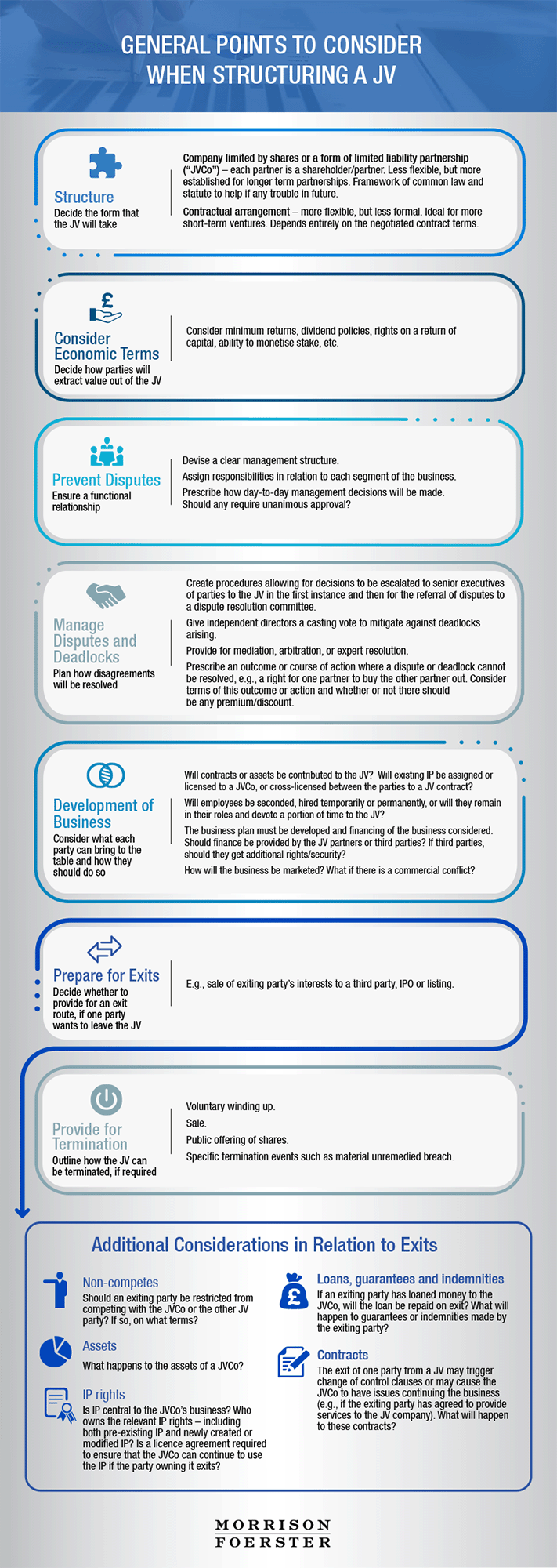Quick Guide to JVs in the Alternative Protein Industry
This article is part of our series on the alternative protein industry, which explores legal considerations relevant to companies and investors in the alternative protein space. The purpose of this article is to provide a quick overview of the key points to consider when entering into a joint venture (“JV”).
Newcomers may wish to read part 1 and part 2 of the series.
Background
Investment in the alternative protein industry is surging, and companies are increasingly capitalising on opportunities to partner with each other in this area. Where the partners bring roughly an equal share to the table, these partnerships may be referred to as JVs. JVs are commercial arrangements agreed between those partners for the purpose of achieving a specific objective. They may be contractual JVs between existing entities without forming a new company, or corporate joint ventures, where a new limited liability company or partnership is formed between the partners. JVs are an effective way for companies to pool technology, expertise and resources in order to generate profit and capture market share.
Some recent JVs in the alternative protein industry have, for example, included partnerships between:
- California-based company Calysta, Inc. and the French subsidiary of China National BlueStar (Group) Co, Ltd., Bluestar Adisseo Co., Ltd. – to focus on producing alternative protein products for the Asian aquaculture market;
- New York-headquartered PepsiCo, Inc. and California-based Beyond Meat, Inc. – to produce a plant-based protein snack and beverage products;
- U.S.-headquartered global food corporation, Cargill, Inc. and Blue Ocean Xlerator NV, a Dutch private incubator and accelerator which created a start-up called Bflike that specialises in vegan fat and blood products – to bring tasty plant-based products to market quickly and affordably; and
- London-headquartered Unilever and Scottish 3FBIO Ltd, trading under the name ENOUGH – to bring plant-based meat products to market; and
- Belgian-headquartered AB InBev and San Francisco based alternative protein producer, Clara Foods, now known as The EVERY Company – to create animal-free protein and develop precision fermentation at scale.
Key Points to Consider when Entering into a JV
1. Diligence on your Potential Partner(s)
It is crucial to consider what you need your partner(s) to bring to the table, and whether they can bring what you need. Spot key risks by asking questions such as:
- Have they had any bad press? Do they have a good reputation?
- What has happened with previous JVs they have been involved with?
- How do other market participants view them?
- Do they have any exclusive supply or purchase agreements in place?
- Do they operate in a heavily regulated space? Are the applicable regulations in flux? Is the company compliant with regulations?
2. Considerations of Specific Importance in the Alternative Protein Industry
Many JVs in the alternative protein industry have typically consisted of partnerships formed by large companies contributing resources and scale, and smaller companies, providing key technology and/or know-how.
Ownership and use of intellectual property rights (“IP”) are clearly key considerations, but marketing and business development planning play a huge role in the success of joint ventures in the food and ag space. Consumer choices are heavily influenced by the prevailing sentiment in a particular country or region, and local or targeted marketing can make a big difference to the success of a joint venture. A few months ago, the phrase “alternative protein” was enough to secure investor and consumer interest alike. However, marketing by more traditional food and ag players has taken some heat out of the market as consumers, although conscious of the environmental impact of their choices, have been reminded about the natural foods agenda and what goes into a particular food product.
Below are considerations that parties might want to consider when evaluating a potential partner.
Large Company with Resources and Scale | Company with Technology and/or Know-How |
|
|
3. General JV Structuring Considerations
The commercial relationship sought between the parties will be what determines the structure and contractual arrangements of the JV. However, below are some general points on structuring a JV.

4. Regulating the JVCo’s Contractual Arrangements
Below are a few more specific points to consider when deciding how to regulate the JVCo’s contractual arrangements and activities.
- Pricing – It is important to prevent the JVCo from being disadvantaged by any restrictions on working with third-party suppliers who might offer more favourable terms. To address this, parties should provide for a competitive tender process in the JV agreement. They should also objectively determine prices and supply terms.
- Double Benefit – if a partner with a supply arrangement with the JVCo benefits from the JVCo being its customer, should this impact the return (dividends) from the JVCo? One party receiving disproportionate benefits from a JV is often a source of disagreement. Parties should assess and prescribe how returns will be allocated accordingly.
Conclusion
Carefully planning the details of how a JV will work will help to ensure that it runs efficiently. Trying to prepare for any issues that may come up is also advisable, as doing so can be instrumental in preserving the relationship between the parties to the JV and could save time and effort on both sides. The general overview of considerations provided in this article is intended to serve as background and may also provide a helpful starting point for companies contemplating a JV.
Julia Kotamäki, London trainee solicitor, contributed to the drafting of this alert.
 Alistair MaughanSenior Counsel
Alistair MaughanSenior Counsel
Practices
Industries + Issues
Regions